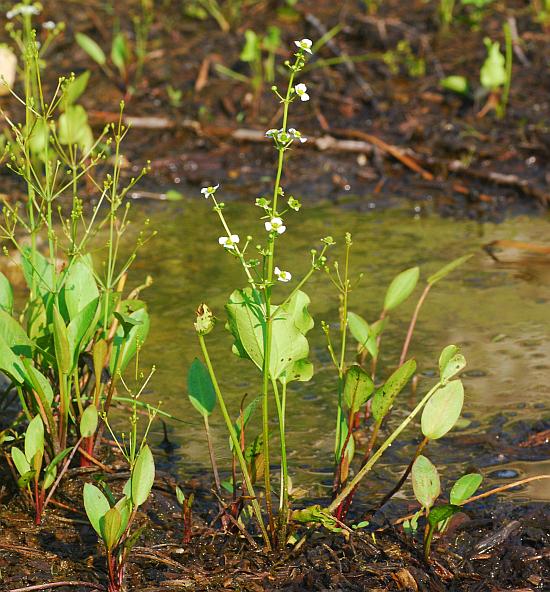Echinodorus berteroi (Spreng.) Fassett
Tall Burhead

Native
CC = 8
CW = -5
MOC = 26
© SRTurner
Echinodorus berteroi (Spreng.) FassettTall Burhead | |
 |
Native CC = 8 CW = -5 MOC = 26 |
© SRTurner |
|
Family - Alismataceae Habit - Annual forb. Leaves - Basal, on long petioles with sheathing bases, 10-60 cm long, the blades ovate with truncate to cordate bases, sometimes lanceolate with more tapering bases in smaller plants, thin-textured and with crisped margins in submerged plants, the tissue with transparent lines mostly less than 1 mm apart and more than 1 mm long (hold leaf up to light), glabrous.
Inflorescence - Erect, with several whorls of 3-8 flowers. On well developed plants later in season, inflorescence may be branched.
Flowers - Trimerous, perfect. Sepals 4-5 mm, ovate, glabrous, persistent, reflexed in fruit. Petals 5-10 mm, broadly ovate, white. Stamens usually 12. Pistils numerous, forming a globose cluster.
Fruits - 2.5-3.5 mm long, brown, beaked, 10-ribbed.
Flowering - July - September. Habitat - Mud flats. Origin - Native to the U.S. Lookalikes - Vaguely, E. cordifolius. Other info. - This species has an interesting distribution, in Missouri being found mostly in counties bordering the Missouri River. Its North American distribution is likewise unusual, comprising two disjunct populations in the Midwest and in western states. Like other members of the Alismataceae, it prefers open muddy areas which are not too heavily overgrown with other vegetation. Under favorable conditions it can form large populations. Photographs taken at Klondike County Park, St. Charles, MO, 8-1-2011, 6-25-2012 and 8-3-2014, near Augusta, St. Charles County, MO, 8-27-2011, and Riverlands Migratory Bird Sanctuary, St. Charles County, MO, 7-21-2013 (SRTurner). |